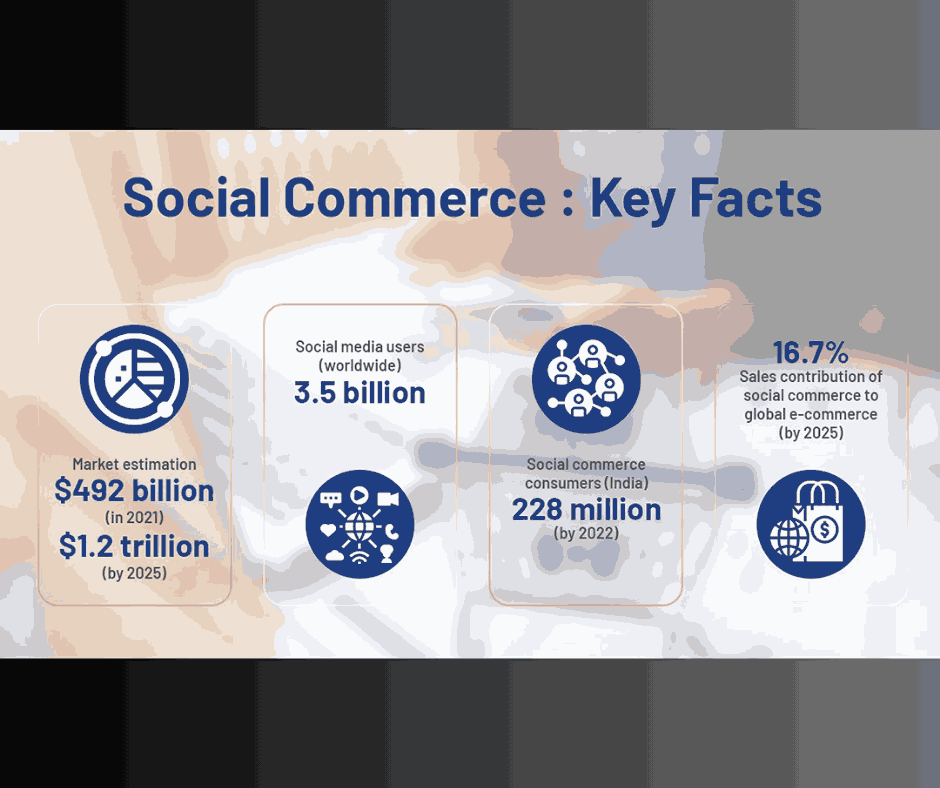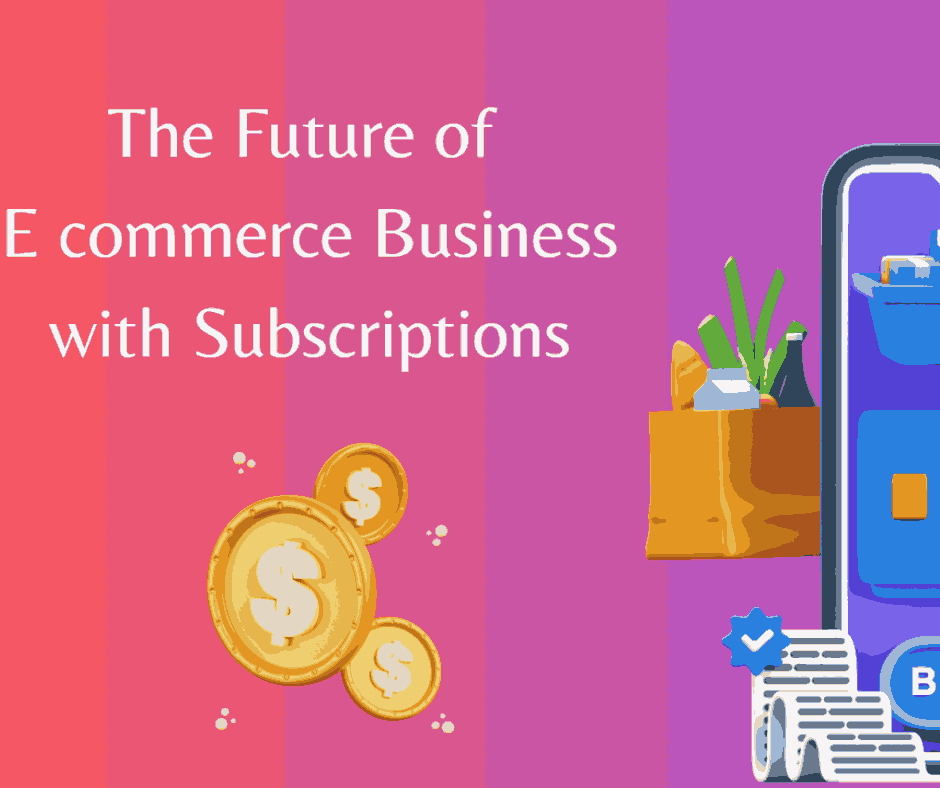In the age of digital innovation and transformation across industries, keeping up with these futuristic commerce trends means that businesses must adapt quickly to continue meeting consumer demand. At the rate that technology is progressing, lots of exciting things are on the horizon for commerce as well. Here are a few of the key future trends in commerce that look most promising to us.
In this article, we discuss the most promising technologies in commerce as well as share commerce technology insights you will love to know about.
Social Commerce: Revolutionising Online Retail

One of the biggest futuristic commerce trends is Social Commerce. Just take a look at how social media is increasingly becoming a powerful sales platform, where customers can buy products directly from places like Instagram, Facebook, TikTok and even Pinterest.
The trend also simplifies the purchasing process; it eliminates the need to exit the platform and navigate external pages providing consumers with a relatively seamless in-app shopping experience. According to TechCrunch, with the rise of social commerce, Facebook Shops & Instagram Shopping have been sending text messages to prospective buyers prompting them to shop.
With Facebook set to exceed $100 billion in social commerce sales by 2025, this is one of the most exciting technologies out there for folks running businesses. Companies that adopt the newest social commerce tools must construct optimised content based on engagement and refine their strategies using detailed analytics.
Omnichannel Retail: Creating a Seamless Shopping Experience
The adoption of omnichannel retail strategies is another key future trend in commerce. This provides a seamless omnichannel retail experience to customers and allows them to effortlessly move between online, in-app, or at-store purchases. The coronavirus pandemic also helped to expedite this nuanced uptake of omnichannel retail, with the adoption trends such as curbside pick-up and online shopping both gathering steam in earnest on behalf of shopping-strapped consumers.
Research also indicates that 73% of shoppers leverage more than one channel for researching and purchasing products, further emphasising the need to implement omnichannel approaches. Omnichannel success means knowing your customers, aligning business objectives and uncovering customer journey bottlenecks. Retailers that embrace omnichannel strategies are in a strong position to deepen customer loyalty and grow revenue over the long term.
Subscription E-commerce: Convenience and Personalisation

The subscription e-commerce industry is growing rapidly and it has been estimated to reach a total value of $899.5 billion by 2028 at an extensive CAGR (Complex Annual Growth Rate) of 79.11%. Powered by consumer demand coming from the expectation of convenience and personalisation, this wave is not restricted to long-existing industries but has moved on to newer sectors such as Healthcare, Fitness, and Education.
Even with the obstacles of data security and market saturation, subscription e-commerce is among the most formidable forces behind some most promising technologies in commerce. However, big companies like Amazon and Shopify have to spend a lot of money on innovation in order not to lag behind. Other future trends in commerce that are big these days include mobile e-commerce, cybersecurity (setting aside the recent Facebook issues), and AI-driven personalisation.
Voice Commerce: The Hands-Free Shopping Revolution
Voice commerce is rapidly emerging as a game-changer in digital shopping, powered by voice assistants like Alexa, Google Assistant, and Siri. This promising technology in commerce enables consumers to complete purchases using verbal commands, offering a seamless, hands-free shopping experience. With over 500 million Alexa devices sold by 2023, voice commerce is expanding beyond Amazon to include retailers like Walmart and Best Buy.
Global voice commerce purchases grew from $4.6 billion in 2021 to nearly $20 billion in 2023, reflecting a 400% increase. As more consumers embrace this technology, businesses are leveraging AI-powered solutions and modern commerce platforms to adopt and optimise voice commerce strategies. The continued growth of voice commerce, driven by advancements in natural language processing (NLP) and AI, positions it as a key future trend in commerce.
AR and VR: Immersive Shopping Experiences

Augmented Reality (AR) and Virtual Reality (VR) are revolutionising the retail industry by creating immersive shopping experiences that blend the physical and digital worlds. AR allows customers to virtually try on products, visualise items in their own spaces, and receive interactive product instructions, reducing the need for physical store visits and minimising returns. VR, on the other hand, enables retailers to create virtual showrooms and product demos, enhancing customer engagement and training employees in risk-free environments.
Leading brands like Sephora, IKEA, and Lowe’s are already leveraging these promising technologies in commerce to improve customer experiences and drive sales. As consumer expectations evolve, adopting AR and VR is becoming essential for retailers to stay competitive. These technologies offer unparalleled personalisation, operational efficiency, and marketing opportunities. As AR and VR continue to integrate with AI, IoT, and 5G, they will further blur the lines between physical and digital retail, making immersive shopping experiences a central part of futuristic commerce trends.
Live Commerce: Blending Entertainment with Instant Purchasing

Live commerce has changed the way we shop, where entertainment meets purchasing instantly. First popularized by Alibaba’s Taobao Live in 2016, consumers can now purchase products directly through a livestream — an interaction that greatly increases consumer engagement and conversion rate.
China has taken live commerce mainstream, with a $171 billion market in 2020 with high conversion rates + strong brand affinity (especially amongst younger shoppers).
Brands like Tommy Hilfiger and Walmart are making their marks in the West with successful live commerce strategies. One of the promising technologies in commerce, live commerce can speed up consumer purchasing processes and offers highly engaging, interactive brand experiences to new consumers. It is on the rise as one of the future trends in commerce. Do not that AR or VR will increasingly spruce up live shopping in times to come.
Blockchain: Enhancing Security and Transparency in E-commerce
Blockchain technology is set to revolutionise e-commerce by addressing key challenges such as data security, transaction transparency, and operational efficiency. Its decentralised nature eliminates the need for intermediaries, reducing costs and streamlining workflows. Blockchain ensures a high level of data security, critical for protecting consumer information in a sector where data breaches can be financially devastating.
Blockchain applications in e-commerce are vast, including inventory control, digital ownership, and loyalty reward programs. For instance, it can automate inventory restocking and ensure accurate tracking of supply chains, thereby enhancing transparency and reliability. As e-commerce continues to grow, integrating blockchain technology will be essential for companies looking to maintain a competitive edge. This technology is undoubtedly one of the most promising technologies in commerce.
Sustainable E-commerce: Aligning with Consumer Values
In the world of e-commerce, sustainability is crucial: more and more businesses are transitioning to greener ways of working in order to offer consumers an approach they hold dear. One of the futuristic commerce trends that is part of this ‘sustainability model’ is a more circular economy powered by recycling; energy from renewables to reduce carbon footprint; and offset emissions-producing transport (like the first-ever zero-emission shipping ferry that uses NH3 as fuel).
Packaging made from biodegradable or recyclable materials provides the most environmentally friendly solution for what is essentially disposable packaging.
Patagonia and Eileen Fisher are successful brands highlighting sustainability in e-commerce by using recycled materials from ethical means and promoting zero-waste lifestyles. They have shown that sustainability goes beyond saving the planet and working together towards making small changes can improve brand reputation and attract eco-conscious consumers — driving profit as well.
With the continued expansion of e-commerce in every sector, implementing sustainability features for downstream success will prove beneficial for both nature and businesses.
Hyper-Personalisation: The Future of Customer Engagement
Hyper-personalisation is an advanced marketing strategy that uses AI and real-time data to create highly specific and individualised customer experiences. Unlike traditional personalisation, hyper-personalisation involves collecting detailed data on customer behaviours, preferences, and interactions to tailor content, products, and services uniquely for each customer.
The benefits of hyper-personalisation include shorter sales cycles, reduced consumer stress, and increased brand loyalty. However, implementing hyper-personalisation is time-consuming and potentially expensive, posing privacy challenges. Companies that successfully adopt this future trend in commerce will gain a competitive edge by delivering personalised experiences that resonate with customers, fostering stronger relationships and higher retention rates.
Conclusion: futuristic commerce trends
In conclusion, staying ahead of futuristic commerce trends and adopting promising technologies in commerce is crucial for businesses aiming to thrive in the evolving digital landscape. By embracing these future trends in commerce and leveraging key commerce technology insights, companies can enhance customer experiences, drive growth, and secure their place in the future of e-commerce.





